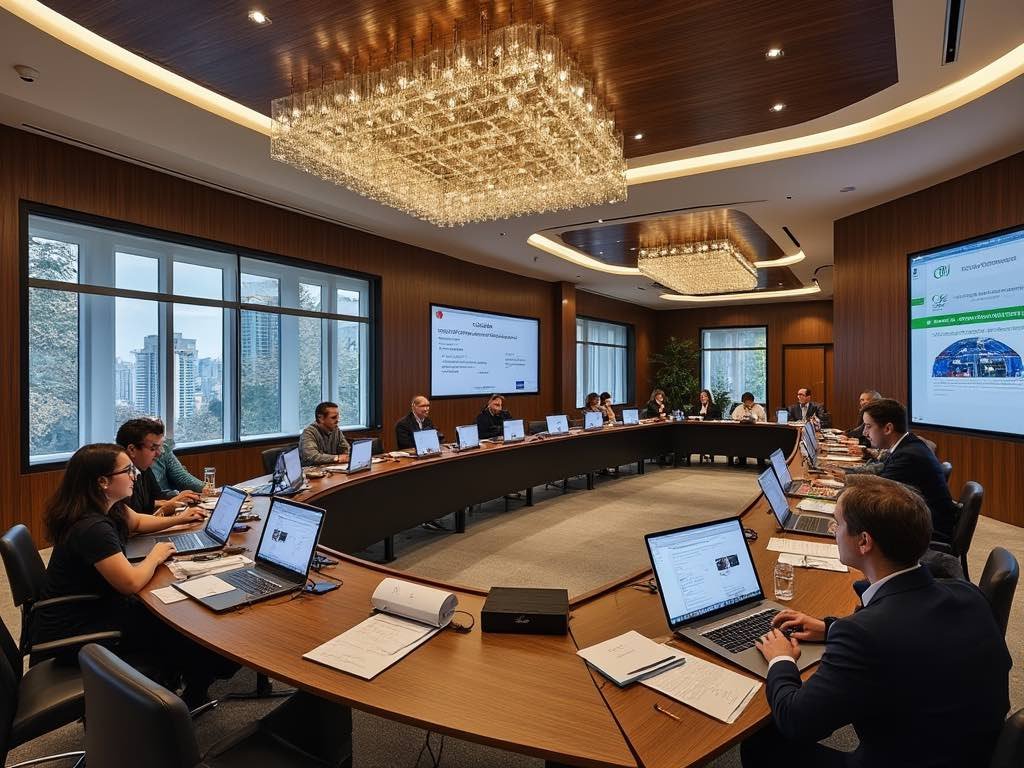Audit Readiness: A CFO’s Roadmap to a Successful Big 5 Audit
As the CFO, we know that preparing for an audit by one of the Big 5 audit firms is akin to training for a marathon. It's more than just balancing the books; it's about ensuring every financial detail, every control, and every compliance measure is in perfect harmony.
When the auditors step into your offices, I want them to see not just numbers, but the robust financial governance we've put in place. It's a testament to our commitment to financial integrity, not just for compliance, but to reassure our stakeholders that we value transparency and accuracy above all.
Join me as I guide our team (by way of the client’s accounting department) through the detailed preparation process; highlighting the critical steps we must take in the lead-up to a Big 5 audit firm arriving onsite.
1. Financial Statement Preparation
Closing and Reconciliation:
Ensure that month-end, quarter-end, and year-end closings are performed promptly.
Reconcile all balance sheet accounts, including cash, receivables, payables, inventory, fixed assets, and debt. This involves matching the general ledger to subsidiary ledgers, bank statements, and other supporting documents.
Pay special attention to reconciling intercompany accounts if your company operates with subsidiaries or affiliates.
Adjustments:
Make sure all necessary year-end adjustments are booked, including:
Accruals for expenses incurred but not yet billed (like utilities, legal fees, etc.).
Prepayments for expenses that have been paid in advance (prepaid insurance, rent, etc.).
Depreciation and amortization calculations are correct and reflect any changes in asset lives or methods.
Revenue cut-off adjustments to ensure income is recognized in the appropriate period.
Document the basis for any unusual or significant adjustments.
Consistency:
Review accounting policies for any changes from the previous year. If changes were made, ensure they are in line with accounting standards and are properly disclosed in the financial statements.
Verify that the application of these policies is consistent across all periods presented unless a change is justified and explained.
2. Documentation and Compliance
Audit Trail:
Maintain a comprehensive audit trail for all transactions. This includes:
Original source documents like invoices, contracts, and receipts.
Supporting schedules that summarize transactions (e.g., depreciation schedules, fixed asset registers).
Sign-offs or approvals for key entries, especially for high-value or unusual transactions.
Policy and Procedure Manuals:
Update all financial policies and procedures to reflect current practices. Ensure these documents cover:
Revenue recognition policies.
Expense capitalization policies.
Inventory valuation methods.
Credit and collections policies.
Investment and financing policies.
Ensure there are clear instructions on how to treat non-routine transactions.
Regulatory Compliance:
Ensure that all financial reporting complies with the relevant accounting standards (GAAP, IFRS).
Keep abreast of any new financial reporting standards or interpretations that might affect your financial statements.
Double-check compliance with industry-specific regulations, where applicable.
3. Internal Controls
Control Environment:
Document the control environment, including:
The tone at the top regarding ethics and integrity.
The organizational structure showing lines of authority and responsibility.
Human resource policies concerning hiring, training, and promoting competent personnel.
Ensure there's a process for regular risk assessment related to financial reporting.
Segregation of Duties:
Map out key financial processes and ensure no single individual has control over all aspects of any financial transaction (e.g., authorization, recording, and custody).
Use matrixes or flowcharts to illustrate the segregation of duties for complex processes.
IT Controls:
Review and document controls over financial data:
Access controls to financial systems.
Change management processes for software updates or modifications.
Data backup and disaster recovery plans.
Security measures against cyber threats.
4. Risk Assessment and Fraud
Risk Identification:
Identify areas where the risk of material misstatement due to error or fraud is high. This includes:
Complex accounting estimates (like bad debt provisions, warranty provisions).
Areas with significant management judgment or complexity.
Transactions with related parties or unusual terms.
Fraud Prevention:
Document and review the effectiveness of:
Anti-fraud policies and procedures.
Whistle-blower programs.
Regular fraud risk assessments.
Training programs on fraud awareness.
5. Inventory and Fixed Assets
Physical Inventory:
Conduct or plan for a physical inventory count, ensuring it's:
Properly planned with clear instructions.
Observed by someone independent if possible.
Reconciled with perpetual inventory records.
Asset Verification:
Ensure the fixed asset register is up-to-date, reflecting:
Additions, disposals, transfers.
Any revaluations or impairments.
Asset locations, if relevant.
Physical verification of assets might be necessary for high-value items.
6. Revenue Recognition
Review Contracts:
Review all significant contracts to ensure compliance with revenue recognition principles:
Under ASC 606 or IFRS 15, identify performance obligations, transaction price, and allocation.
Ensure revenue is recognized when (or as) the performance obligation is satisfied.
Cut-off Testing:
Implement procedures to ensure that revenue is recorded in the correct period:
Review sales orders, invoices, and shipping documents around the period end.
Test for any manipulation or 'channel stuffing' to meet sales targets.
7. Taxation
Tax Provision:
Calculate the current and deferred tax provisions accurately:
Review taxable income computations.
Ensure all tax credits and deductions are correctly applied.
Reconcile tax accounts and ensure all tax deposits are made on time.
Deferred Taxes:
Review deferred tax assets and liabilities for changes due to:
New tax laws or rates.
Changes in temporary differences between book and tax bases.
Valuation allowances on deferred tax assets.
8. Intercompany Transactions
Reconciliations:
Perform detailed reconciliations of intercompany accounts:
Ensure all transactions are matched and eliminated in consolidation.
Document any unresolved differences with explanations or action plans.
9. Audit Preparation
PBC List:
Compile a comprehensive list of all documents the auditors will need, including:
Trial balance and general ledger details.
Detailed schedules for significant accounts.
Reconciliations.
Supporting documents for major transactions or balances.
Start gathering these documents well before the audit to avoid last-minute rushes.
Pre-Audit Meetings:
Arrange meetings with the audit team to:
Discuss the audit plan, scope, and objectives.
Highlight any significant changes in the business or accounting practices.
Address any preliminary concerns or questions from either side.
Training and Awareness:
Prepare staff through:
Training sessions on the audit process and expectations.
Mock audits or walkthroughs of key processes.
Role clarification regarding audit interactions.
10. Review by Management
Management Review:
Conduct a thorough management review of all financial statements and notes:
For accuracy, completeness, and adherence to accounting standards.
To ensure that all disclosures are clear and relevant.
Analytical Procedures:
Perform analytical reviews:
Compare current year figures with prior periods and budgeted amounts.
Use ratios, trends, and variances to highlight any anomalies that need explaining.
11. Contingencies and Commitments
Legal and Contingency Reviews:
Update the schedule of contingencies:
Legal proceedings, claims, or potential liabilities.
Commitments like lease agreements, purchase commitments, or guarantees.
Assess the likelihood and potential financial impact of these items.
12. Governance and Ethics
Board Minutes:
Ensure all board meetings are documented, with minutes:
Reflecting financial policies, significant transactions, and strategic decisions.
Showing oversight of financial reporting and internal controls.
Do’s & Don’t Tips for your Organization
Preparing for an audit can be a complex endeavor, but with the right approach, it can also be an opportunity to strengthen your organization's financial integrity. Here are some essential do's and don'ts to guide you through the process.
These tips are crafted from our seasoned financial officers and audit professionals, ensuring that your company not only passes the audit with flying colors but also emerges from it with improved practices and a better understanding of its financial health. You should feel comfortable in sharing this article as a friendly gesture and to use as a helpful agenda when meeting on the subject. Of course, we are here to help at Promenade Advisors.
Do:
Do Plan Early: Start the preparation process months in advance. Early planning allows you to address potential issues without the pressure of an impending deadline.
Do Document Everything: Keep detailed records of all transactions, policies, and internal control procedures. Documentation should be clear, concise, and easily accessible.
Do Perform Regular Internal Audits: Conducting your own internal audits or reviews can help identify and correct issues before the external auditors arrive.
Do Train Your Staff: Ensure that all team members involved in the audit process understand their roles, what to expect, and how to interact with auditors. This reduces the risk of miscommunication.
Do Communicate with Auditors: Engage with the audit team early. Understand their expectations, timelines, and any specific areas of focus for the upcoming audit.
Do Review and Adjust: Use the audit preparation time to review financial statements and make necessary adjustments. Ensure all financial data is accurate and up-to-date.
Do Test Internal Controls: Regularly test your internal controls to ensure they are functioning as intended. Document these tests and their outcomes.
Do Keep Up with Accounting Standards: Stay informed about changes in accounting standards and ensure your financial reporting complies accordingly.
Do Address Known Issues: If you're aware of any discrepancies or areas of concern, address them proactively rather than waiting for auditors to find them.
Do Prepare Checklists: Use checklists to ensure nothing is overlooked. This includes checklists for document preparation, control assessments, and compliance reviews.
Don't:
Don't Rush: Avoid the temptation to rush through the preparation. Hasty preparations can lead to oversights and mistakes.
Don't Hide Information: Transparency is key. Do not withhold information or documents from auditors, as this can lead to trust issues and potentially more scrutiny.
Don't Underestimate the Importance of Segregation of Duties: Failing to have proper segregation can be a significant red flag for auditors. Ensure responsibilities are appropriately divided.
Don't Overlook IT Controls: With the increasing reliance on technology, neglecting to review and document IT controls can leave a gaping hole in your audit readiness.
Don't Skip Reconciliations: All accounts should be reconciled and any discrepancies resolved. Skipping this step can lead to audit findings.
Don't Wait for the Audit to Start: Don't wait for auditors to point out issues with your financial statements or controls. Proactive identification and resolution is always better.
Don't Assume: Don't assume auditors understand your business operations. Provide them with background information on your industry, operations, and any unique transactions.
Don't Ignore Past Audit Findings: If previous audits resulted in findings, ensure these have been addressed or that you have a plan to address them.
Don't Neglect Communication: Good communication isn't just with auditors; ensure there's also clear internal communication about the audit process and expectations.
Don't Overlook Small Details: Sometimes it's the small, seemingly insignificant errors that can unravel a larger audit issue. Attention to detail is crucial.
Wrapping Up
As we wrap up this exploration of audit preparation, remember that the journey doesn't end when the auditors leave. The insights gained and the processes refined during this period are invaluable.
They fortify our financial practices, enhance our control environment, and prepare us not just for the next audit, but for ongoing operational excellence. By embracing this preparation phase not as a mere checklist exercise, but as an opportunity for growth and improvement, we set the stage for a future where financial health is not just maintained but continuously optimized.
Let this audit be the catalyst or an opportunity for a culture shift of meticulousness and foresight in your financial operations, ensuring that your company not only meets but exceeds the expectations of all stakeholders.
Navigating this balance with an Expert CFO is Critical
At Promenade Advisors, our CFO Services will be the go-to source that you need to manage your existing accounting team and in some cases rebuild a team from scratch. We have the experience to assess what you need and what to prioritize. Contact us today for a free consultation.



